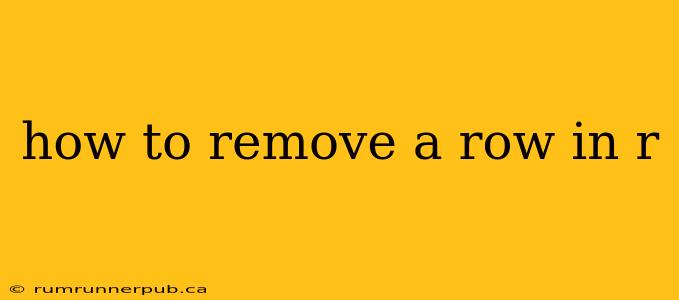Removing rows from a data frame is a fundamental task in R data manipulation. This article explores various methods, drawing upon insights from Stack Overflow, and providing practical examples and explanations to enhance your understanding.
Methods for Removing Rows in R
Several approaches exist for deleting rows in R, each with its strengths and weaknesses. We'll cover the most common and efficient techniques.
1. Subsetting with [
This is arguably the most straightforward and versatile method. You essentially create a new data frame excluding the rows you want to remove. This is based on boolean indexing.
Example: Let's say we have a data frame df:
df <- data.frame(
A = c(1, 2, 3, 4, 5),
B = c("a", "b", "c", "d", "e")
)
To remove the third row (where A is 3), we can use:
new_df <- df[-3, ] # -3 indicates removal of the 3rd row
print(new_df)
Explanation: The -3 within the square brackets indicates that the third row should be excluded. The trailing comma , ensures that all columns are retained.
Stack Overflow Relevance: Many Stack Overflow questions regarding row removal boil down to this basic subsetting technique. The challenge often lies in constructing the correct logical condition for row selection.
2. Using filter() from dplyr
The dplyr package provides a more readable and efficient way, especially for complex conditions. filter() allows you to specify conditions to keep rows that meet specific criteria. To remove rows, you specify the opposite condition.
Example: To remove rows where A is greater than 2:
library(dplyr)
new_df <- df %>% filter(A <= 2)
print(new_df)
Explanation: filter(A <= 2) keeps only the rows where A is less than or equal to 2. This effectively removes rows where A is greater than 2.
Stack Overflow Relevance: Numerous Stack Overflow threads feature solutions using dplyr::filter(), particularly when dealing with multiple conditions or more complex filtering logic. This approach is preferred for its clarity and efficiency in larger datasets. The use of %in% for checking membership in a set is also very common in such scenarios.
3. Removing Rows Based on Row Names
If your data frame has row names, you can remove rows based on those names:
Example:
rownames(df) <- LETTERS[1:5] # Assigning row names
new_df <- df[!rownames(df) %in% c("C", "E"), ] # Removing rows with names "C" and "E"
print(new_df)
Explanation: !rownames(df) %in% c("C", "E") creates a logical vector. %in% checks if the row names are present in the vector c("C", "E"). The ! negates the result, keeping rows whose names are not in the specified set.
Stack Overflow Relevance: This scenario arises when row identifiers are meaningful and you need to remove rows based on those identifiers.
4. Removing Rows with subset()
The subset() function offers a more concise way to filter rows based on conditions:
Example:
new_df <- subset(df, A <= 2) # same result as dplyr::filter(A <= 2)
print(new_df)
Explanation: It directly filters rows based on the provided condition.
Choosing the Right Method
The best method depends on your specific needs:
- For simple row removal based on row number, use basic subsetting with
[ ]. - For complex conditional removal,
dplyr::filter()provides better readability and efficiency. - Use row name based removal if row names are your primary identifiers.
subset()provides a more concise alternative to basic subsetting for conditional filtering.
This article provides a comprehensive overview of various methods for removing rows in R. Remember to always back up your original data frame before performing any row deletion operations to avoid unintended data loss. Remember to consult the Stack Overflow community for more specific issues or advanced techniques. They're a valuable resource for tackling almost any R-related challenge!
